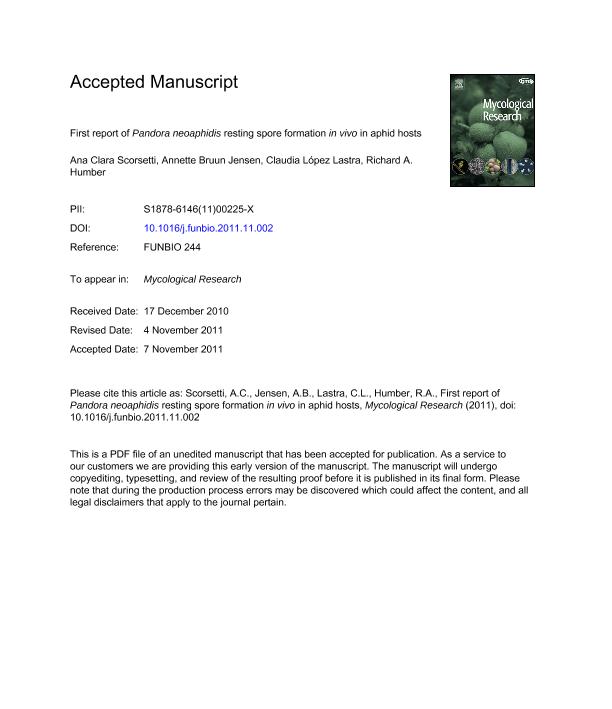Mostrar el registro sencillo del ítem
dc.contributor.author
Scorsetti, Ana Clara

dc.contributor.author
Jensen, Annette Bruun
dc.contributor.author
Lopez Lastra, Claudia Cristina

dc.contributor.author
Humber, Richard A.

dc.date.available
2019-03-25T15:29:11Z
dc.date.issued
2012-02
dc.identifier.citation
Scorsetti, Ana Clara; Jensen, Annette Bruun; Lopez Lastra, Claudia Cristina; Humber, Richard A.; First report of Pandora neoaphidis resting spore formation in vivo in aphid hosts; Elsevier; Fungal Biology; 116; 2; 2-2012; 196-203
dc.identifier.issn
1878-6146
dc.identifier.uri
http://hdl.handle.net/11336/72413
dc.description.abstract
The entomopathogenic fungus Pandora neoaphidis is a recognized pathogen of aphids, causes natural epizootics in aphid populations, and interacts and competes with aphid predators and parasitoids. Survival of entomophthoralean fungi in periods of unsuitable weather conditions or lack of appropriate host insects is accomplished mainly by thick-walled resting spores (zygospores or azygospores). However, resting spores are not known for some entomophthoralean species such as P. neoaphidis. Several hypotheses of P. neoaphidis winter survival can be found in the literature but so far these hypotheses do not include the presence of resting spores. Resting spores were found in an aphid population where P. neoaphidis was the only entomophthoralean fungus observed during surveys conducted in organic horticultural crops in greenhouses and open fields in Buenos Aires province, Argentina. This study sought to use molecular methods to confirm that these resting spores were, in fact, those of P. neoaphidis while further documenting and characterizing these resting spores that were produced in vivo in aphid hosts. The double-walled resting spores were characterized using light and transmission electron microscopy. The Argentinean resting spores clustered together with P. neoaphidis isolates with bootstrap values above 98 % in the small subunit ribosomal RNA (SSU rRNA) sequence analysis and with bootstrap values above 99 % the Internal Transcribed Spacer (ITS) II region sequence analysis. This study is the first gene-based confirmation from either infected hosts or cultures that P. neoaphidis is able to produce resting spores.
dc.format
application/pdf
dc.language.iso
eng
dc.publisher
Elsevier

dc.rights
info:eu-repo/semantics/openAccess
dc.rights.uri
https://creativecommons.org/licenses/by-nc-nd/2.5/ar/
dc.subject
Entomopathogenic Fungi
dc.subject
Entomophthorales
dc.subject
Pandora Neoaphidis
dc.subject
Resting Spores
dc.subject
Winter Survival
dc.subject.classification
Otras Ciencias Biológicas

dc.subject.classification
Ciencias Biológicas

dc.subject.classification
CIENCIAS NATURALES Y EXACTAS

dc.title
First report of Pandora neoaphidis resting spore formation in vivo in aphid hosts
dc.type
info:eu-repo/semantics/article
dc.type
info:ar-repo/semantics/artículo
dc.type
info:eu-repo/semantics/publishedVersion
dc.date.updated
2019-03-15T20:25:53Z
dc.journal.volume
116
dc.journal.number
2
dc.journal.pagination
196-203
dc.journal.pais
Países Bajos

dc.journal.ciudad
Amsterdam
dc.description.fil
Fil: Scorsetti, Ana Clara. Universidad Nacional de La Plata. Facultad de Ciencias Naturales y Museo. Instituto de Botánica Spegazzini; Argentina. Consejo Nacional de Investigaciones Científicas y Técnicas. Centro Científico Tecnológico Conicet - La Plata; Argentina
dc.description.fil
Fil: Jensen, Annette Bruun. Universidad de Copenhagen; Dinamarca
dc.description.fil
Fil: Lopez Lastra, Claudia Cristina. Consejo Nacional de Investigaciones Científicas y Técnicas. Centro Científico Tecnológico Conicet - La Plata. Centro de Estudios Parasitológicos y de Vectores. Universidad Nacional de La Plata. Facultad de Ciencias Naturales y Museo. Centro de Estudios Parasitológicos y de Vectores; Argentina
dc.description.fil
Fil: Humber, Richard A.. Center for Agriculture and Health; Estados Unidos
dc.journal.title
Fungal Biology

dc.relation.alternativeid
info:eu-repo/semantics/altIdentifier/url/http://www.sciencedirect.com/science/article/pii/S187861461100225X
dc.relation.alternativeid
info:eu-repo/semantics/altIdentifier/doi/https://doi.org/10.1016/j.funbio.2011.11.002
Archivos asociados
